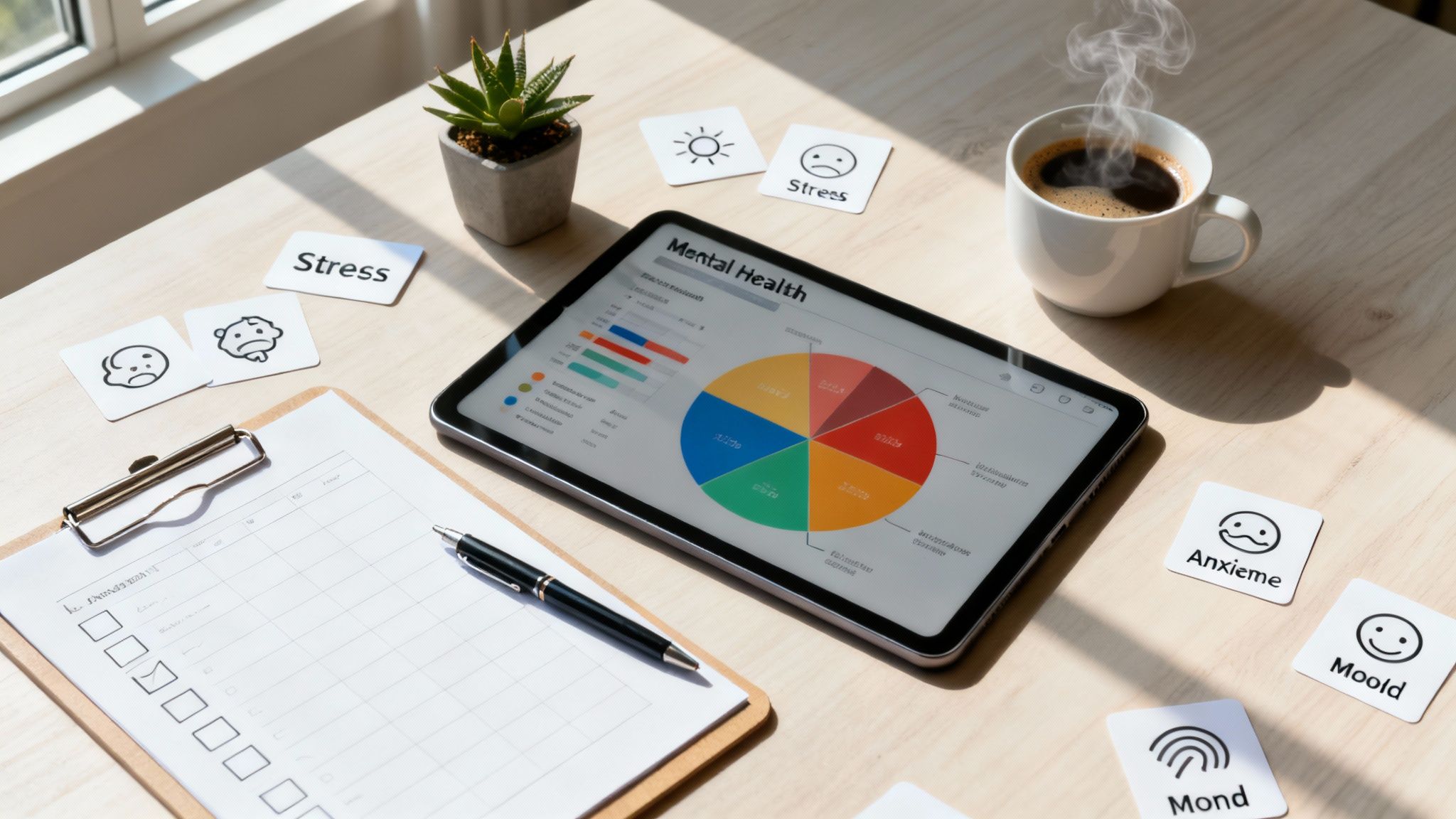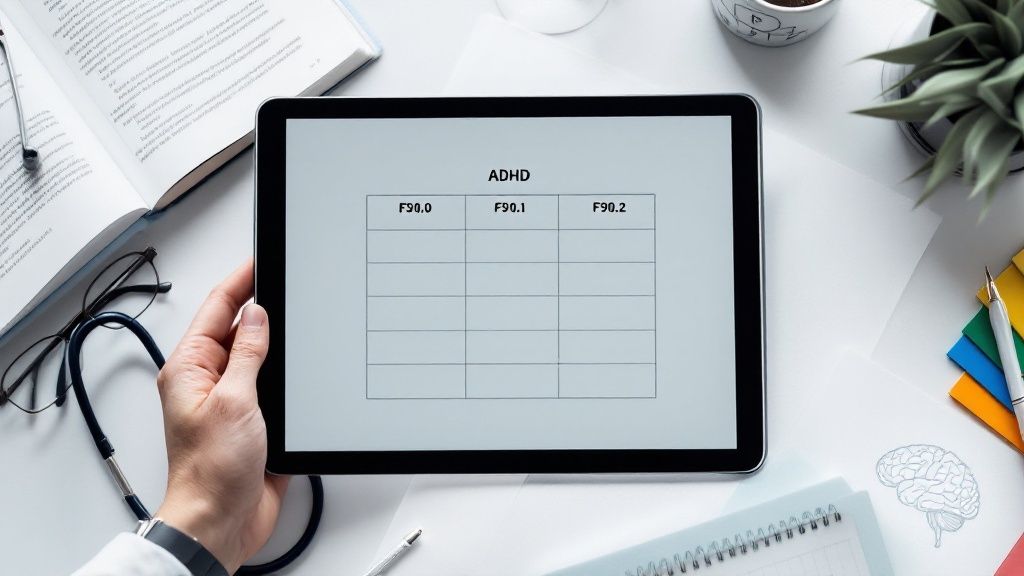Uncover the Real Reasons for Procrastination and How to Move Forward
Procrastination is not a sign of laziness. It's an emotional response our brain uses to avoid uncomfortable feelings tied to a task, like anxiety, self-doubt, or boredom. This isn't a character flaw; it’s a deeply human way of coping with challenging emotions. Understanding this helps us shift from self-blame to self-compassion. When you know the real reasons for procrastination, you can find kinder, more effective ways to move forward. Why Procrastination Is More Than Just a Bad Habit Have you ever scrolled through your phone when a deadline is near, feeling a growing sense of dread? This common experience shows that procrastination is less about managing time and more about managing emotions. It's a way we protect ourselves from feelings of stress and anxiety. Our brains are wired to seek immediate comfort. Faced with a difficult task, we often choose a distraction to get a quick sense of relief, even if it leads to more stress later. In the high-pressure academic and professional settings in India and globally, this can affect our well-being and lead to burnout. This mind map shows how procrastination is often linked to our emotional state. As you can see, putting things off is often a direct response to internal challenges, not just a lack of effort. Recognising this pattern in our own lives is the first step toward building resilience. Common Procrastination Triggers and Their Emotional Roots
Recognising these connections is a key step. The goal isn't to eliminate the feeling but to learn how to act with self-compassion even when it’s present. Shifting from Self-Blame to Self-Compassion Once you understand the emotional roots of procrastination, you can change your approach. The next time you delay a task, gently ask, "What feeling am I trying to avoid right now?" This shift opens the door to kinder and more effective solutions. Procrastination can also be linked to , which affects the brain's ability to plan, organise, and start tasks. Learning about can offer a new way to understand these challenges.
Ultimately, this journey is about creating a supportive inner environment. A compassionate mindset helps you acknowledge your feelings without letting them take over, which is key to breaking free from the procrastination loop. Exploring the Emotional Roots of Delay Often, the real reasons we procrastinate are not on our to-do lists but deep within us. Delay is a way we protect ourselves from feelings that seem too uncomfortable to face. Understanding these emotional drivers is the first step toward a healthier relationship with our tasks and ourselves. At its heart, procrastination is often tied to . This isn't just a vague worry but a specific fear of being judged negatively. For example, a student in India might put off a major project not because they can't do the work, but because the thought of their professor's critique feels overwhelming. This kind of avoidance is common in high-pressure settings. Research shows that evaluation anxiety is a major reason for procrastination among college students in India and around the world. One study found that of students delayed weekly reading assignments, often due to a fear of being assessed poorly. You can . The Perfectionism Paralysis Perfectionism is another powerful trigger for delay. It traps us in an all-or-nothing mindset where the pressure to be flawless is so great that we avoid starting at all. The internal thought is often, "If I can't do it perfectly, I won't do it." This isn't about high standards; it's about setting impossibly high ones that lead to inaction. This cycle fuels and gets in the way of both well-being and personal growth. The Weight of Low Self-Esteem How we see ourselves plays a huge role in our motivation. When we struggle with low self-esteem, we often believe we are not capable of succeeding. This internal story can be shaped by past experiences, making us hesitant to take on new challenges. Each new task can feel like another opportunity to fail, creating a difficult cycle. Breaking this pattern requires more than time management; it demands building self-compassion and . This is where and can be very helpful, offering a safe space to challenge these beliefs and cultivate a more supportive inner voice.
These emotional reasons for procrastination are not signs of weakness. They are deeply human responses to perceived threats. Acknowledging these feelings without judgment is the most compassionate and effective first step toward regaining control and improving your overall well-being. How Your Thoughts and Surroundings Can Trap You in Procrastination Sometimes, the reasons for procrastination are hiding in plain sight—in our thoughts and our environment. The stories we tell ourselves about a task or our own abilities can either help us get started or stop us completely. This is more than just a lack of willpower; it's often about how we think. Many of us are not good at guessing how long a task will take. This is known as the , and it's a common setup for procrastination. The Problem of "Decision Paralysis" Have you ever felt so overwhelmed by choices that you did nothing at all? That's . It happens when a task is too vague or the options are too numerous, making it feel easier to avoid making a choice. A student in India choosing a project topic might feel lost in hundreds of options, making it impossible to start. This isn't laziness; it's a common reaction to feeling overloaded that can trigger stress and .
When Your Environment Is the Enemy Our physical space matters a great deal. It’s hard to focus when your environment is working against you. Trying to work in a chaotic room or study in a noisy space is an invitation to procrastinate. Lacking the right tools for a job can also be a real barrier. These practical issues are not just excuses; they can make getting started feel like an enormous effort. Poor time management is a common thread, especially in high-pressure situations. An Indian study found that cited poor time management as the top reason they procrastinated. You can . This cycle of stress can impact mental health, sometimes contributing to and if not addressed. The Link Between Procrastination and Mental Health Putting things off occasionally is normal. But when procrastination becomes a constant, draining pattern, it might be a sign of a deeper mental health challenge. The internal struggle can make getting started feel impossible. Understanding this connection is a compassionate first step toward getting support. Chronic procrastination often co-exists with conditions like ADHD, , and . This is for awareness, not self-diagnosis, but exploring these links can be helpful. The Role of ADHD and Executive Function For someone with ADHD, procrastination is often a result of . Executive functions are your brain's management system for planning, organising, and starting tasks. When this system faces challenges, it's a neurological hurdle, not a lack of effort. This can show up in a few key ways:
The Cycle of Anxiety and Avoidance Anxiety and procrastination can create a difficult cycle. When a task makes you anxious, your brain's instinct is to avoid it. This brings a moment of relief, reinforcing procrastination as a coping strategy. However, that relief is temporary. The task remains, which increases and . Breaking this pattern often means addressing the root cause of the anxiety, sometimes with the help of professional .
Depression and the Loss of Motivation Depression can make even simple actions feel incredibly difficult. Its core symptoms—fatigue, loss of interest, and feelings of hopelessness—directly impact motivation. In this context, procrastination isn't a choice; it's a symptom. The self-criticism that often accompanies it can worsen feelings of worthlessness and fuel the cycle of . Rebuilding your strength takes self-compassion, patience, and often professional . Building starts with acknowledging that the struggle is real and that you deserve support on your journey to well-being. Building Resilience with Compassionate Strategies Knowing why you procrastinate is a breakthrough. The next step is learning to respond to yourself with compassion instead of criticism. This shift helps you move from harsh self-discipline into the world of positive psychology and builds lasting . Building resilience is about creating a kinder inner dialogue. Instead of asking, "What's wrong with me?" you can start asking, "What do I need right now?" This small change in perspective can make a big difference in breaking the cycle of avoidance and building positive momentum toward . Start with Small, Actionable Steps Feeling overwhelmed is a major trigger for procrastination. Breaking tasks down into very small pieces can lower the barrier to starting. This helps rebuild trust in your ability to follow through. Here are a couple of simple yet powerful techniques:
Remember to celebrate these small wins. Every task you complete is proof of your progress. This is how you build the and confidence needed to take on bigger challenges. For more great ideas, check out these . Prioritise Compassion and Well-Being Lasting change comes from treating yourself with kindness. Self-compassion is about acknowledging that challenges are difficult without adding self-judgment. It’s a powerful antidote to the shame that fuels procrastination and can worsen feelings of or .
This kind approach should extend to all parts of your life, including rest. "Bedtime procrastination"—delaying sleep for leisure activities despite being tired—is a growing issue, especially for students. One study found that about of Indian university students regularly did this, often due to academic pressure and late-night digital use. Improving your sleep by setting a consistent bedtime is a crucial act of self-care. These are supportive takeaways, not promises of a cure, to help you move forward in a healthier way. When to Seek Professional Support While self-help strategies can be very effective, sometimes procrastination is a sign of a deeper issue that needs professional support. Reaching out for help is a sign of strength and an investment in your long-term . It shows you are ready to take charge when the struggle feels too difficult to manage alone. Signs It Might Be Time for Therapy How do you know when it's time to seek support? If procrastination consistently disrupts your work, relationships, or mental health, it may be time to consider professional or . Look out for these recurring patterns:
A therapist acts as a guide, helping you see the connections between your feelings and actions. They can provide practical tools to manage difficult emotions, reframe unhelpful thoughts, and develop strategies that build genuine . The goal is a deeper understanding of yourself and a more balanced, compassionate approach to life. Frequently Asked Questions About Procrastination You might still have some questions, and that's perfectly normal. Let's walk through some common ones to provide more clarity on the reasons for procrastination. Is Procrastination a Sign of Laziness? No, it’s a common misconception. Procrastination is not about being lazy; it's an emotional coping mechanism. Our brain tries to avoid feelings like stress, boredom, or fear of failure. Understanding this allows you to stop self-criticism and approach the problem with more kindness. This shift is the first step toward real change and improved . Can Procrastination Be Linked to Anxiety or Depression? Yes, there is a strong connection. If you are dealing with , the fear of not doing something perfectly can be paralysing. With , symptoms like low energy and hopelessness can make even small tasks feel overwhelming. If you suspect your procrastination is tied to these deeper feelings, seeking professional can be a supportive step. A therapist can help you untangle these overlapping challenges. What Is the First Step I Can Take to Stop Procrastinating? The best place to start is with a small, kind action. Try the 'two-minute rule': commit to doing a task for only two minutes. This simple trick lowers the mental barrier and often helps you continue for longer.
This small action interrupts the cycle of avoidance that fuels and personal . It creates space for something new to happen. These supportive takeaways are practical steps, not promises of a cure, to help you on your journey. Ready to understand your own patterns and start building a more resilient you? Explore our confidential, science-backed assessments or connect with a qualified therapist on . Find the support you need to move forward with confidence and happiness at .

































































